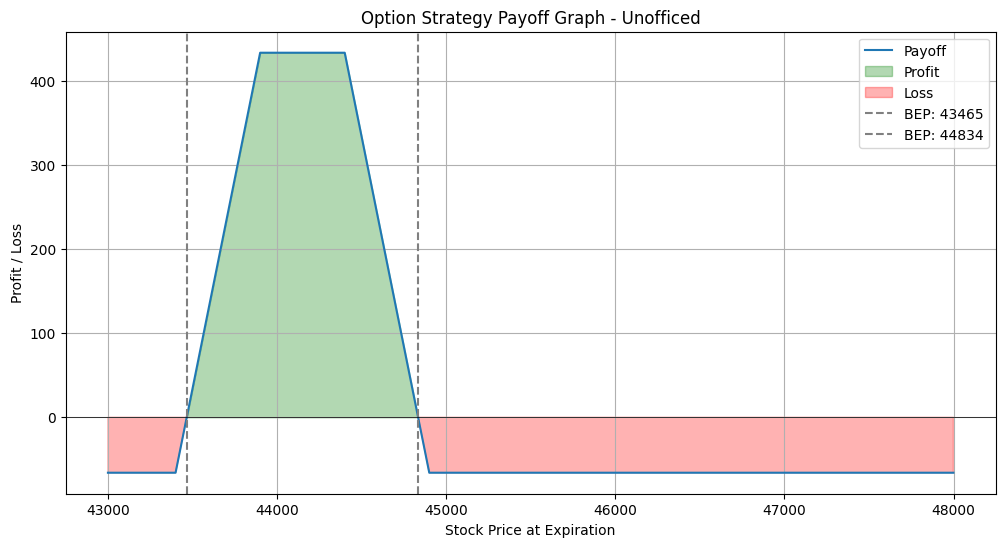Bearish Condor Spread
The Bearish Condor Spread is an options trading strategy tailored for a moderately bearish market outlook.
This strategy is designed to benefit from a slight decrease in the price of the underlying asset and involves a combination of buying and selling put options at different strike prices.
Setup of the Bearish Condor Spread
- Buy Higher Strike Put:
- Action: Purchase a put option that is either at-the-money (ATM) or slightly in-the-money (ITM).
- Rationale: This put option gains value if the underlying asset’s price decreases, forming the basis of the bearish outlook.
- Sell Higher Middle Strike Put:
- Action: Sell a put option with a strike price slightly lower than the bought put.
- Rationale: This helps recoup some of the cost of the bought put and begins to establish the lower boundary of the profit range.
- Sell Lower Middle Strike Put:
- Action: Sell another put option with a strike price lower than the first sold put.
- Rationale: Further offsets the cost and extends the lower boundary of the profit range.
- Buy Lower Strike Put:
- Action: Purchase a put option with a strike price lower than both sold puts.
- Rationale: This limits the downside risk by capping potential losses if the underlying asset’s price decreases significantly beyond expectations.
Live Example:
- Buy BANKNIFTY 44900PE at 95.05 – 1 Lot
- Sell BANKNIFTY 44400PE at 25.35 – 1 Lot
- Sell BANKNIFTY 43900PE at 7.2 – 1 Lot
- Buy BANKNIFTY 43400PE at 3.5 – 1 Lot
The strikes are all equidistant from each other as it is a condor spread.
It is a put spread as it is entirely made with put options.
Ideal Implied Volatility Environment: High IV
The strategy is more effective in a high implied volatility environment, as this can increase the premiums of the sold options, enhancing potential profits.
Profit and Loss Dynamics
- Maximum Profit: The distance between the strikes of the sold puts (500 points, i.e., 44400 – 43900) minus the net debit incurred from setting up the spread.
- Net Debit: Calculated as the premiums of bought puts minus the premiums of sold puts (95.05 + 3.5 – 25.35 – 7.2) = 66.
Breakeven Points
- Upper Breakeven: Strike price of the higher sold put (44400) minus the net debit. 44400 – 66 = 44334.
- Lower Breakeven: Strike price of the lower sold put (43900) plus the net debit. 43900 + 66 = 43966.
Here is the payoff graph –

The trader would reach the maximum profit potential if the price of the underlying asset is near the middle and strikes at expiration.
The strategy yields a profit if the price at expiration is between the two breakeven points (43465 and 44834).
The Bearish Condor Spread is designed for a moderately bearish market outlook, offering a balanced risk-reward profile.
It is crucial for the trader to closely monitor market movements and manage the positions, particularly as the expiration date approaches, to optimize the outcome of the spread.
Bearish Condor for Downward Movement:
- If the market approaches the lower breakeven point and a downward trend is anticipated, a Bearish Condor might be more suitable.
- The Bearish Condor Spread is structured to benefit from a slight decline in the market, again with more profit potential near its breakeven points.
Strategically deploying a Bullish or Bearish Condor Spread at the breakeven points of an existing strategy can be an effective way to adapt to sudden market movements. This approach allows for potential profit maximization near the breakeven points and provides an opportunity to exit and rebalance your position with minimal loss.
However, this strategy requires a keen understanding of market dynamics, precise timing, and diligent risk management.

